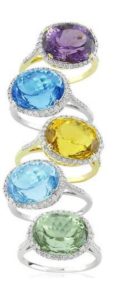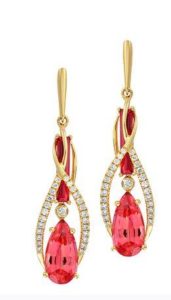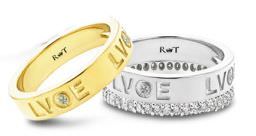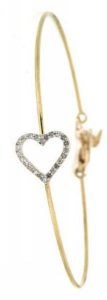2016: Transitioning to Millennials
While a lot rides on the winter holiday selling season as to how 2015 ends and the New Year begins in retail, the overall strategy for jewelers’ success in 2016 and beyond relies on greater understanding, outreach, and service of millennials.
 As a generation, millennials are at least as large as, if not larger than, Baby Boomers, their parents born 1946 to1964. Over the next two decades, the Boomers will move into retirement with dramatic changes in consumption patterns, and Millennials will become the leading consumer force. According to Unity Marketing, the most important target among millennials will be young affluents (35 to 44 year-olds) who historically spend one-and-one-half to two times more than older affluents (45 to 54 year-olds) on luxury goods and services.
As a generation, millennials are at least as large as, if not larger than, Baby Boomers, their parents born 1946 to1964. Over the next two decades, the Boomers will move into retirement with dramatic changes in consumption patterns, and Millennials will become the leading consumer force. According to Unity Marketing, the most important target among millennials will be young affluents (35 to 44 year-olds) who historically spend one-and-one-half to two times more than older affluents (45 to 54 year-olds) on luxury goods and services.
The peak years to capture their market share, based on population demographics, will be 2026 to 2029. Pam Danziger, president of the Stevens, Pennsylvania-based luxury market research firm, advocates that marketers start planning now, as the transition will begin in 2018. She underscores that millennials will be as different from the generations that went before as the Boomers were from their Depression/World War II era parents.
KEY FACTORS
Millennials are creating a whole new definition and expression of luxury. Here are some key trends to watch in this space:
Mobile Matters: Millennials do not need to go to a store unless they choose to, reminds Liz Chatelain, president of the Los Angeles-based MVI Marketing and its Jewelry Consumer Opinion Council. “Mobile is critical. A year from now, it will be all mobile—smartphones, tablets, and watches. The idea of people sitting with a laptop or in front of a computer screen to search and shop is not the direction in which things are moving. If you don’t have mobile access to shopping as part of your e-commerce, you’re already behind the times.”
The growth of mobile, says Chatelain, has been rapid. “Mobile is not the lead yet, but from zero to a third of e-commerce in 18 months, that’s substantial growth,” she says. E-commerce accounts for about 9% of total retail sales, which is expected to reach about 11% by 2018. She advocates that jewelers check databases/messaging for e-commerce and mobile to understand how it relates to their consumers.
Build Brand Value: The market is a buzz over Blue Nile’s concept store, “Webroom,” at Roosevelt Field Mall in Garden City, New York. Danziger likens it to Apple’s Genius Bar, designed to help clients navigate the vast online diamond inventory and style options it offers in a personal setting. The diamond ring retailer realizes that to succeed, it must be more than just diamonds for less. Blue Nile wants to build a brand and to do so, it needs emotional and meaningful ways to connect with consumers. Speaking to the imperative for jewelers to deliver personalized experiences, she advocates retailers align their brand, products, and services with consumers’ need for fun and recreation. “Small is the next big in retail!”
Kate Peterson, president of Performance Concepts, Montgomery Village, Maryland, underscores that “you can’t build value based on product.” She says that while millennials want unique, personal jewelry that tells a story, any product can be all that. “Sales associates must know how to sell what they have and become personal shoppers for their customers, to take the burden off them to make gift decisions and remember occasions.” She believes the shift for retailers to have a physical presence bodes well for traditional jewelers who have one toe in e-commerce and are evolving their digital footprint.
New Rules of Engagement: The diamond engagement ring market has changed since Blue Nile started in 1999. The marriage rate is down from 8.6 marriages per 1,000 people then to a historic low of 6.8 today. “Not only are fewer people choosing to marry,” cites Danziger, “but many are forgoing the diamond tradition in favor of other stones or symbols.”
Notably, millennials are open to man-made stones. “They like the idea because they don’t have to worry about where it came from and think the technology is cool,” says Chatelain. “Millennials don’t have a history and romance with diamonds like their parents and grandparents.” She cites news of a company producing lab-grown diamonds backed by billionaires, including Blood Diamond star Leonardo Di Caprio. “Di Caprio is tweeting about it, getting other celebrities involved. This could really turn the diamond business on its ear. The diamond market is already experiencing inventory issues; prices and qualities are down, there are no places to mine, and it’s expensive to build out. Inventory will start to shrink, even with talk of recycled diamonds in the market.”
 Chatham Created Gems also is finding a new following in young consumers, focusing brand marketing on millennials with three distinctive campaigns: Fresh Gems, Never Mined, and Arts & Science. “Each campaign reflects Chatham’s innovative brand positioning,” explains Monica McDaniel, communications manager of the San Marcos, California-based brand. “We’re looking to speak to millennial customers, appealing to them with a product that is conflict-free, eco-friendly, and revolutionary in technology—the future of the jewelry industry.”
Chatham Created Gems also is finding a new following in young consumers, focusing brand marketing on millennials with three distinctive campaigns: Fresh Gems, Never Mined, and Arts & Science. “Each campaign reflects Chatham’s innovative brand positioning,” explains Monica McDaniel, communications manager of the San Marcos, California-based brand. “We’re looking to speak to millennial customers, appealing to them with a product that is conflict-free, eco-friendly, and revolutionary in technology—the future of the jewelry industry.”
Todd Wolleman, Color Craft, New York City, cites color in general as a key area of growth not only in fashion jewelry but also in bridal. “Color has the rarity factor, fashion connection, and personalized meaning—there’s something for everyone.” Among the most popular choices for bridal are fancy color diamonds, blue and fancy sapphires, and many traditional birthstones.
Retailers can expect marriage equality to evolve wedding jewelry trends and traditions, says Rony Tennenbaum, designer of the “Art of Contemporary Love” brand, EMA Jewelry, New York. “With same-sex marriage, new protocols are forming. There are new dynamics, new opportunities for diamond rings for brides and grooms.” According to the Gay Wedding Institute, 66% of women purchase engagement rings, 19% of men—which Tennenbaum expects will rise with greater marketing and merchandise selection of men’s bands. He notes that early adopters will reap the benefits of this growing segment of a key category.
Wearable Technology: “It has a future, particularly for independent jewelers. If we don’t grab it and make it everything it can be, we’ll lose it to Best Buy. Curate a selection for your customers. It will get people in store, especially millennials.”
Robert Herskovits of MJJ Brilliant, New York, advocates jewelers to get in on the ground floor. “Innovative companies creating these products want to partner with jewelers. We’ve found in our research that women are most interested in the category. They’re looking for ways to simplify their life—products that have fashion styles and functions that help them get through the day (i.e., reminders, ways to stay in touch, security features). Good wearable tech has to have a purpose, be multi-functional, with an underlying emotional component.”
According to the NPD Group, independent cellular connectivity is one of the key differentiators that will accelerate smartwatch growth even further in the coming year. Other types of smart devices, such as activity trackers and digital fitness devices, have already seen significant growth and will continue to do so.







